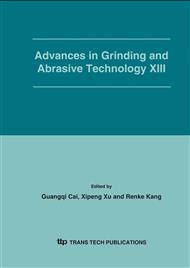p.355
p.359
p.364
p.369
p.374
p.379
p.384
p.389
p.393
A Basic Study on Precision in Electrochemical Abrasive Lapping of Plate
Abstract:
Taking plate as the example, this paper studies the effect of tool’s shape and movement on the electrochemical as well as mechanical lapping characteristics in Electrochemical Abrasive Lapping (ECAL). It is assumed that the removal size of electrochemical action at a random point is in direct proportion to the electrical amperage through this point and the removal size of the lapping action is in direct proportion to the relative frictional distance. Based on the assumption above, electrochemical and mechanical lapping characteristics with different tools shape are studied theoretically. The results show that the diameter of the tool should be larger than the width of the workpiece when a discal tool is used and the inner diameter of the tool should be larger than the width of the workpiece when a ringed tool is used, on the other hand the ratio of the revolving radius of the tool to the diameter of the tool as larger as possible avails to improve the precision and so does the ratio of the angular velocity of the workpiece to the rotating angular velocity of the tool.
Info:
Periodical:
Pages:
374-378
Citation:
Online since:
February 2006
Authors:
Price:
Сopyright:
© 2006 Trans Tech Publications Ltd. All Rights Reserved
Share:
Citation:


